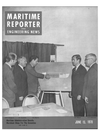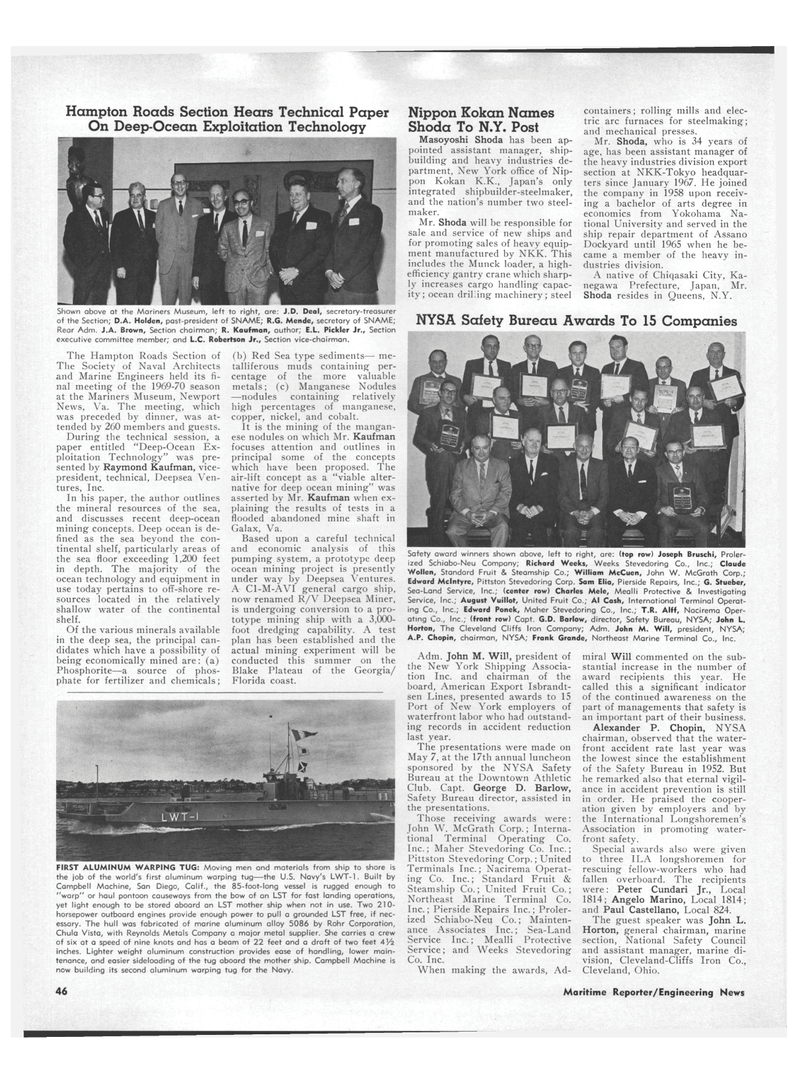
Page 44: of Maritime Reporter Magazine (June 15, 1970)
Read this page in Pdf, Flash or Html5 edition of June 15, 1970 Maritime Reporter Magazine
Hampton Roads Section Hears Technical Paper
On Deep-Ocean Exploitation Technology
Shown above at the Mariners Museum, left to right, are: J.D. Deal, secretary-treasurer of the Section; D.A. Holden, past-president of SNAME; R.G. Mende, secretary of SNAME;
Rear Adm. J.A. Brown, Section chairman; R. Kaufman, author; E.L. Pickler Jr., Section executive committee member; and L.C. Robertson Jr., Section vice-chairman.
The Hampton Roads Section of
The Society of Naval Architects and Marine Engineers held its fi- nal meeting of the 1969-70 season at the Mariners Museum, Newport
News, Va. The meeting, which was preceded by dinner, was at- tended by 260 members and guests.
During the technical session, a paper entitled "Deep-Ocean Ex- ploitation Technology" was pre- sented by Raymond Kaufman, vice- president, technical, Deepsea Ven- tures, Inc.
In his paper, the author outlines the mineral resources of the sea, and discusses recent deep-ocean mining concepts. Deep ocean is de- fined as the sea beyond the con- tinental shelf, particularly areas of the sea floor exceeding 1,200 feet in depth. The majority of the ocean technology and equipment in use today pertains to off-shore re- sources located in the relatively shallow water of the continental shelf.
Of the various minerals available in the deep sea, the principal can- didates which have a possibility of being economically mined are: (a)
Phosphorite—a source of phos- phate for fertilizer and chemicals; (b) Red Sea type sediments— me- talliferous muds containing per- centage of the more valuable metals; (c) Manganese Nodules —nodules containing relatively high percentages of manganese, copper, nickel, and cobalt.
It is the mining of the mangan- ese nodules on which Mr. Kaufman focuses attention and outlines in principal some of the concepts which have been proposed. The air-lift concept as a "viable alter- native for deep ocean mining" was asserted by Mr. Kaufman when ex- plaining the results of tests in a flooded abandoned mine shaft in
Galax, Va.
Based upon a careful technical and economic analysis of this pumping system, a prototype deep ocean mining project is presently under way by Deepsea Ventures.
A Cl-M-AVI general cargo ship, now renamed R/V Deepsea Miner, is undergoing conversion to a pro- totype mining ship with a 3,000- foot dredging capability. A test plan has been established and the actual mining experiment will be conducted this summer on the
Blake Plateau of the Georgia/
Florida coast.
Nippon Kokan Names
Shoda To N.Y. Post
Masoyoshi Shoda has been ap- pointed assistant manager, ship- building and heavy industries de- partment, New York office of Nip- pon Kokan K.K., Japan's only integrated shipbuilder-steelmaker, and the nation's number two steel- maker.
Mr. Shoda will be responsible for sale and service of new ships and for promoting sales of heavy equip- ment manufactured by NKK. This includes the Munck loader, a high- efificiency gantry crane which sharp- ly increases cargo handling capac- ity; ocean drilling machinery; steel
Adm. John M. Will, president of the New York Shipping Associa- tion Inc. and chairman of the board, American Export Isbrandt- sen Lines, presented awards to 15
Port of New York employers of waterfront labor who had outstand- ing records in accident reduction last year.
The presentations were made on
May 7, at the 17th annual luncheon sponsored by the NYSA Safety
Bureau at the Downtown Athletic
Club. Capt. George D. Barlow,
Safety Bureau director, assisted in the presentations.
Those receiving awards were:
John W. McGrath Corp.; Interna- tional Terminal Operating Co.
Inc.; Maher Stevedoring Co. Inc.;
Pittston Stevedoring Corp.; United
Terminals Inc.; Nacirema Operat- ing Co. Inc.; Standard Fruit &
Steamship Co.; United Fruit Co.;
Northeast Marine Terminal Co.
Inc.; Pierside Repairs Inc.; Proler- ized Schiabo-Neu Co.; Mainten- ance Associates Inc.; Sea-Land
Service Inc.; Mealli Protective
Service; and Weeks Stevedoring
Co. Inc.
When making the awards, Ad- containers; rolling mills and elec- tric arc furnaces for steelmaking; and mechanical presses.
Mr. Shoda, who is 34 years of age, has been assistant manager of the heavy industries division export section at NKK-Tokyo headquar- ters since January 1967. He joined the company in 1958 upon receiv- ing a bachelor of arts degree in economics from Yokohama Na- tional University and served in the ship repair department of Assano
Dockyard until 1965 when he be- came a member of the heavy in- dustries division.
A native of Chiqasaki City, Ka- negawa Prefecture, Japan, Mr.
Shoda resides in Queens, N.Y. miral Will commented on the sub- stantial increase in the number of award recipients this year. He called this a significant indicator of the continued awareness on the part of managements that safety is an important part of their business.
Alexander P. Chopin, NYSA chairman, observed that the water- front accident rate last year was the lowest since the establishment of the Safety Bureau in 1952. But he remarked also that eternal vigil- ance in accident prevention is still in order. He praised the cooper- ation given by employers and by the International Longshoremen's
Association in promoting water- front safety.
Special awards also were given to three ILA longshoremen for rescuing fellow-workers who had fallen overboard. The recipients were: Peter Cundari Jr., Local 1814; Angelo Marino, Local 1814; and Paul Castellano, Local 824.
The guest speaker was John L.
Horton, general chairman, marine section, National Safety Council and assistant manager, marine di- vision, Cleveland-Cliffs Iron Co.,
Cleveland, Ohio.
FIRST ALUMINUM WARPING TUG: Moving men and materials from ship to shore is the job of the world's first aluminum warping tug—the U.S. Navy's LWT-1. Built by
Campbell Machine, San Diego, Calif., the 85-foot-long vessel is rugged enough to "warp" or haul pontoon causeways from the bow of an LST for fast landing operations, yet light enough to be stored aboard an LST mother ship when not in use. Two 210- horsepower outboard engines provide enough power to pull a grounded LST free, if nec- essary. The hull was fabricated of marine aluminum alloy 5086 by Rohr Corporation,
Chula Vista, with Reynolds Metals Company a major metal supplier. She carries a crew of six at a speed of nine knots and has a beam of 22 feet and a draft of two feet 414 inches. Lighter weight aluminum construction provides ease of handling, lower main- tenance, and easier sideloading of the tug aboard the mother ship. Campbell Machine is now building its second aluminum warping tug for the Navy.
NYSA Safety Bureau Awards To 15 Companies
Safety award winners shown above, left to right, are: (top row) Joseph Bruschi, Proler- ized Schiabo-Neu Company; Richard Weeks, Weeks Stevedoring Co., Inc.; Claude
Wollen, Standard Fruit & Steamship Co.; William McCuen, John W. McGrath Corp.;
Edward Mclntyre, Pittston Stevedoring Corp. Sam Elia, Pierside Repairs, Inc.; G. Stueber,
Sea-Land Service, Inc.; (center row) Charles Mele, Mealli Protective & Investigating
Service, Inc.; August Vuillot, United Fruit Co.; Al Cash, International Terminal Operat- ing Co., Inc.; Edward Ponek, Maher Stevedoring Co., Inc.; T.R. Alff, Nacirema Oper- ating Co., Inc.; (front row) Capt. G.D. Barlow, director. Safety Bureau, NYSA; John L.
Horton, The Cleveland Cliffs Iron Company; Adm. John M. Will, president, NYSA;
A.P. Chopin, chairman, NYSA; Frank Grande, Northeast Marine Terminal Co., Inc. 46 Maritime Reporter/Engineering News

 43
43

 45
45
